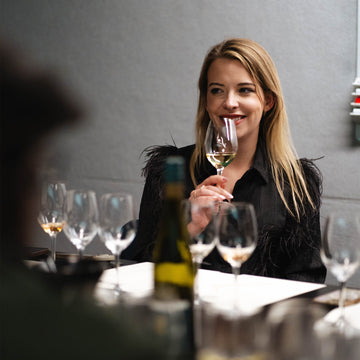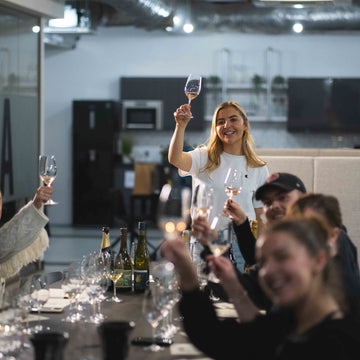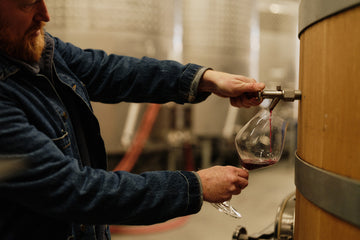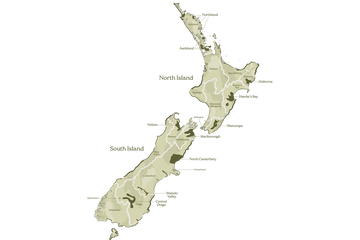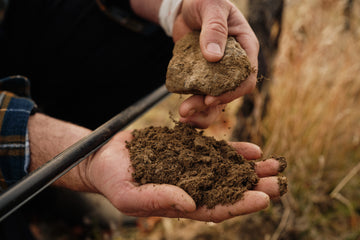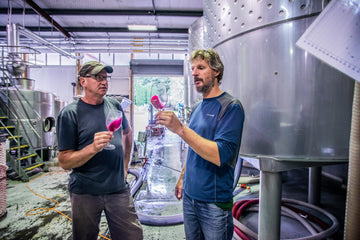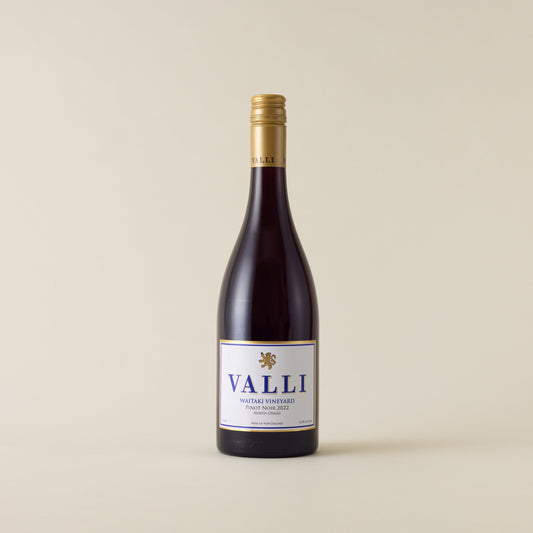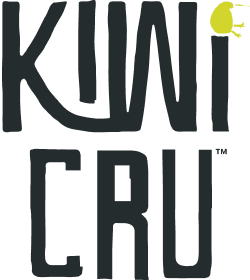Explore the regions – the Waitaki Valley’s extraordinary geology, cool climate and lingering autumn ripening period make for unique and exciting wines, says Te Kano winemaker Dave Sutton.
Waitaki Valley wines; a synergy of geology, climate, and passionate ‘believers’
Built on the bones of a prehistoric seabed, the uplift of an ancient fault line, and the legacy of glacier and river flows, the Waitaki Valley occupies an extraordinary geological niche. But it’s the cool climate and long dry ripening season, influenced by the Southern Alps to one side and the Pacific Ocean to the other, that clinches the deal for New Zealand’s second to smallest wine region.
Winemakers here, smack bang on the 45th parallel (latitude of some of the world’s most famed vineyards), revel in being part of a relatively new and undeniably small appellation, its 50 hectares of vines accounting for a sliver of New Zealand’s 42,519 ha total. “It’s totally unique”, says Te Kano Winemaker Dave Sutton, Chair of Waitaki Winegrowers, who has championed the valley since 2020, when the Central Otago company bought a winery in this neighbouring region, linking landlocked Central Otago with the South Island’s east coast.
The sale included a vineyard that had been dormant for five years, and they spent a few winter seasons rebuilding vine structure, “to see if it was worth pursuing”. When the first fruit came off the vines in 2022 it was a “wow moment”, Dave says, eyes lighting up at the memory of “zingy” flavours and retained acids. “The wines are so expressively aromatic. They jump out of the glass at you”, he says. “The aroma spectrum is so different from Central – really perfumed, and lifted, and very, very vibrant”. The aroma follows through into the first taste, with energy, elegance and perfume at play, resulting in “intriguing” wines.
The Pinot Gris shows green ginger, “spicy and intriguing”, juxtaposed with tropical characters and chalkiness from the limestone soils. “It’s very elegant and very defined, and it makes a great case for how Pinot Gris reflects terroir”.
The Pinot Noir has both dried herbal flavours and bright fruit, treading an elegant line between the red and black side of ripeness. Meanwhile, the Chardonnays have high acidity alongside ripe flavours, adding up to “overall intensity”, despite being on the lower side of alcohol levels, he says. “Because we are picking at lower brix but full maturity”.

Valli Wines founder Grant Taylor has been similarly smitten since 2014, when he was given a parcel of Chardonnay fruit from the valley and thought, “holy hell I need to own land over here”. He trialled another parcel in 2016 and found wine “so true to itself”. For someone with a passion for subregional wines, and their ability to reflect specific attributes of terroir, the synergies of geology and climate in Waitaki were irresistible.
Grant says the valley’s limestone undoubtedly makes a difference, including through its water holding capacity, which means vines can access what they need without being waterlogged. But for him the climate – cool, maritime and on the edge of viability – makes the wines the way they are. “There’s this really long hang time, so you have great acidity but ripeness”.
The industry here is young, with the first few players planting in 2001, seeing potential in a north facing slope of limestone, created from the remains of marine organisms millions of years ago, overlaid with eroded glacial material deposited by the wide braided Waitaki River, with its source at Aoraki Mt Cook, the tallest mountain in New Zealand.
In 2008, when the global financial crisis crossed paths with a global wine glut, many of the Waitaki players began to pull attention from the emerging region, focusing instead on their primary growing areas.
Those who remain are the “believers”.

Te Kano’s Unique Place in Waitaki
Dave grew up in Wellington, New Zealand’s capital, and loved classes in the school’s vegetable gardens. He heeded the advice of his horticulture teacher, who thought farming would be a stretch for the city kid but suggested winemaking and viticulture instead.
On completing his degree at Lincoln University, and a year of hands-on mentoring at Matador Estate in Marlborough, Dave worked a series of vintages abroad, including South Australia, California, Chile, Spain, Germany, Australia and France.
In 2010 he returned to New Zealand for harvest and was working the nightshift in a large Marlborough winery when he took a call from a friend working at Peregrine Wines in Central Otago. “He said, ‘if you can get here tomorrow there’s a job for you’”. Dave finished his shift, quit his job, packed up his flat, drove nine hours to Gibbston Valley and immediately started work. Snow fell during harvest that year, “and I remember thinking, ‘this place is something special’”.
Vintages in France and South Australia followed, but when another call came from Central Otago, Dave immediately quit his job in the Barossa Valley. The Te Kano winery purchase in 2020 saw him move to Waitaki just as Covid-19 lockdowns hit New Zealand. Winemaking was deemed an essential service, so Dave, his wife and their newborn son lived in the office above the winery during the first vintage.
He says the companies that remain in Waitaki are there for passion, not profit, and the level of collaboration makes for a committed community of winegrowers. “We all really believe in it”.
Valli’s Subregional Passion
Sitting in the beautiful Valli Wine Bar in Kurow, established with his wife Nicole Schofield in 2024, Grant Taylor is helping grow a tiny town of contrasts. The wine bar (giving new life to an old Post Office) is an elegant urban foil to the two classic country pubs and rural supply shops dominating the street. Meanwhile those streets play host to shearers and dairy farmers – from the valley’s hills and plains respectively – as well as wine tourists, and Lycra clad visitors navigating the Alps 2 Ocean cycle trail.
Grant was born here, at the heart of the Waitaki Valley, although his childhood was largely on the move, thanks to his father being a stationmaster with the railway. His adult life was mobile too, exploring the world’s wine regions and forging a reputation in Napa, California, before putting down roots in Central Otago in 1993. Grant established Valli in 1998, with a subregional focus that pays homage to place. That passion was piqued in 2014, when he tasted a parcel of Waitaki Chardonnay grapes, going on to buy vineyard land, and to return (salmon-like, he says) to where his life began. “Coming back here, it feels like home”.
He and Nicole now live on a remote block up the beautiful Hakataramea Valley, north of Kurow, where life is quiet and neighbours distant. But he can frequently be found talking to locals and visitors at the wine bar, where we try a glass of Valli’s Waitaki Valley Chardonnay – a wine that sells out the day it is released, apart from the cases squirreled away for lucky wine bar visitors.
Valli’s season starts in Central Otago’s Bannockburn, then moves through Bendigo and Gibbston, before winding up in Waitaki two months in, with the long dry autumn providing ripe fruit that retains good acid. “Here you have all the time in the world”, Grant says. Having the Valli brand has been critical to opening eyes, and palates, to Waitaki, he adds. But with those palates increasingly keen to taste more, and 40,000 visitors cycling through each year on the Alps 2 Ocean, including those who come to the wine bar for a tasting and order a case before leaving, Valli’s Waitaki wines are standing sturdily on their own two feet. And they’re doing so in very select company. “I used to be upset when I saw vines being pulled out”, Grant says. But these days he celebrates the niche place he and other believers occupy. “We all know what rarity does for wines”.

